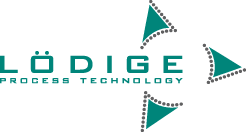In addition to reliable process functionality, an efficient cleaning process of the horizontal mixing system like the Lödige Ploughshare® Mixer is becoming increasingly important. An integrated cleaning system is frequently requested a basic equipment for a new machine. Particular emphasis is placed on the prevention of cross-contamination by allergens, flavours and active ingredients during product changeovers, as well as the elimination of potential microbiological contamination.
In general, cleaning systems for process-related equipment can be divided into two categories: semi-automatic WIP (wash-in-place) systems and fully automatic CIP (clean-in-place) systems. The latter do not require any manual cleaning steps. The Lödige horizontal mixing systems generally use a WIP system, since minor manual steps are frequently required, e.g. removing a filter or installing a drainage cone on the machine outlet. The system can be chemically disinfected, as needed, after machine cleaning. This is referred to as a SIP system (sterilisation-in-place).
Complex cleaning process
The cleaning process itself comprises residue-free removal of any remaining product and material build-up anywhere in mixing drum. The air-purged seals of the mixing shaft and choppers are flushed with water to prevent the ingress of cleaning water. Subsequently, the Ploughshare® Mixer is successively cleaned from top to bottom. For this purpose, all sockets on top of the machine are fitted with cleaning nozzles – either firmly welded on the inside of the socket or to be positioned on the socket as a separate washing adapter. It is also possible to install automated retractable cleaning nozzles. Filters are generally completely moistened while installed and then removed for further cleaning (e.g. in a dishwasher or ultrasonic bath).
The rinsing water used for cleaning the sockets is collected in the mixing drum and later used for cleaning the mixer interior, which requires a filling level of 10–20 % with cleaning agent. The mixing drum itself is cleaned by forward and backward rotation of the mixing shaft, effectively ensuring intense, turbulent contact between the mixer inner surface and the cleaning media. If necessary, any product residue remaining in the mixer can be soaked during this process. Mixing systems with higher volumes use additional rotating jet cleaners to maintain a reasonable water consumption per cleaning cycle. Both fresh water or closed-loop circulation mode can be used for this process.
Automatic cleaning of the mixer discharge is a more sophisticated process, due to the complex geometry of the discharge door, drive shaft and sealing surfaces. A combination of static cleaning nozzles and a centrally located rotating spray ball, as well as opening and closing the door in interval mode have proven successful for intense cleaning of all surfaces. Any waste water created by the cleaning process is discharged through a drainage cone installed at the mixer discharge.
Depending on product solubility and the degree of machine soiling, the cleaning process can be performed in multiple steps using cold, warm or purified water. Automatic metered addition of various cleaning agents, as well as a final chemical disinfection are also available. If the mixer design includes the necessary equipment, thermal sterilisation can also be carried out using steam. Final drying of the mixer with conditioned ambient air is possible, supported by the use of hot water in the previous cleaning steps. Faster alternatives, such as blowing out the entire system with heated compressed air or using blowers combined with air dehumidifiers, referred to as absorption dryers, have also proven effective.
Modular structure of the cleaning systems
All WIP, CIP or SIP systems for horizontal mixers have a modular structure, enabling them to meet any customer- and product-specific task requirements. Each cleaning process is defined by mixer design and product properties, and is reproducibly saved in the machine control system.
A riboflavin test is used to ensure correct functionality of the cleaning system (e.g. number and positioning of the nozzles) as well as correct parametrisation of the cleaning process (e.g. water volume, rinsing times, etc.). Riboflavin glows if it is illuminated by ultraviolet light, and is used as tracer for visual inspection. However, this test is only an indicator of cleaning effectiveness. It cannot be used to validate the cleaning process.











